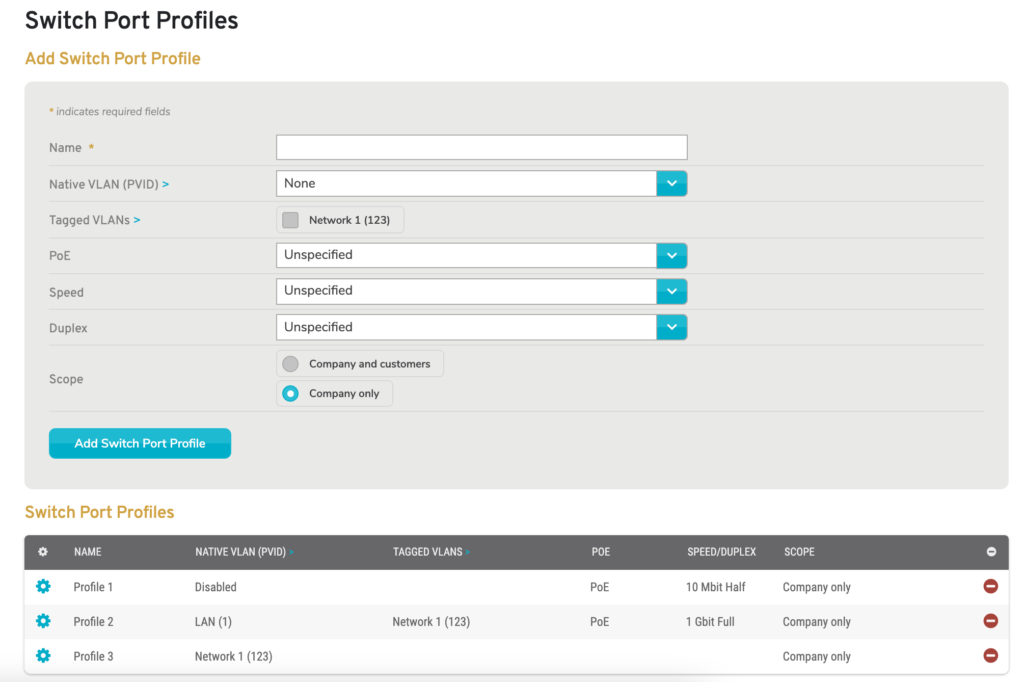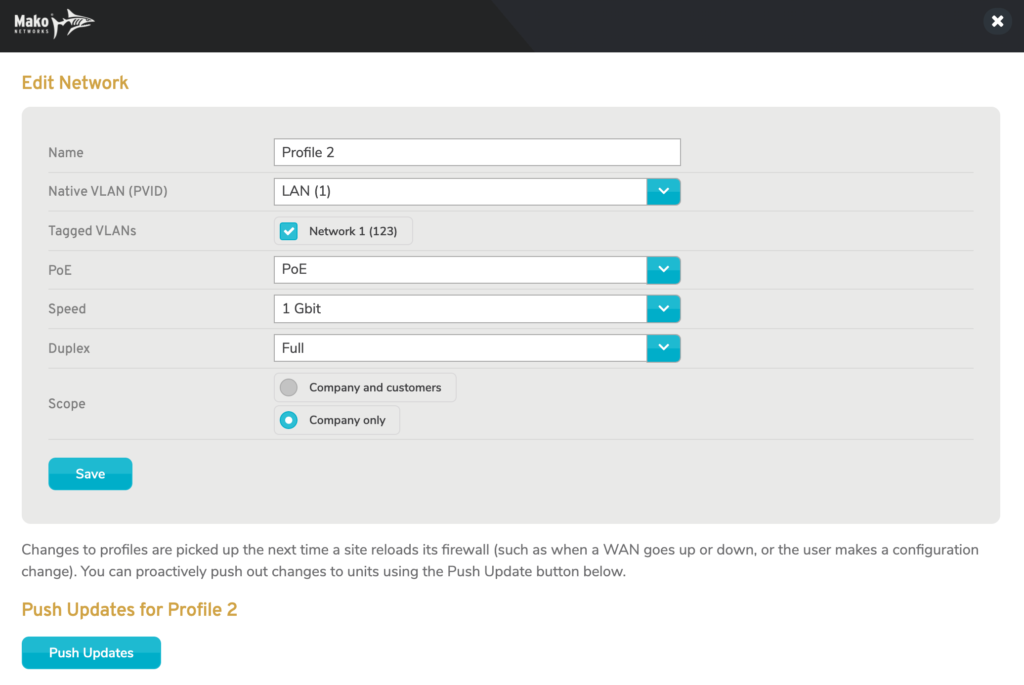This topic is ONLY relevant to managed switches. It is NOT relevant to security gateways.
Overview

Figure 1. Example Switch Port Profiles Page
The Switch Port Profiles page (Fig. 1) allows you to manage switch port profiles for the selected company that can then be assigned to specific ports on Mako managed switches.
Add Switch Port Profile

Figure 2. Example Add Switch Port Profile Form
Use the Add Switch Port Profile form (Fig. 2) to create a new switch port profile and to make it available for the selected company’s Mako managed switches.
Name
Enter an informative, memorable, and unique name for this switch port profile.
Native VLAN (PVID)
Choose the VLAN ID to use for untagged VLAN traffic on ports that use this switch port profile.
This is typically VLAN 1 or the LAN subnet of the connected Mako.
Tagged VLAN
Choose which Tagged VLANs can use ports that use this switch port profile.
This is typically used to pass customer VLANs to a second switch or other device while ensuring no CDE VLANs are available to the other device.
PoE
Choose the Power over Ethernet (PoE) setting for this switch port profile:
- Disabled – PoE is explicitly disabled for the port
- PoE – PoE is explicitly enabled for the port
Speed
Choose the speed setting for this switch port profile:
- Auto – automatically detect the best speed setting
- 10 Mbit
- 100 Mbit
- 1 Gbit
Duplex
Choose the duplex setting for this switch port profile:
- Auto – automatically detect the best duplex setting
- Half – half-duplex connections allow communication in two directions, but only in one direction at a time
- Full – full-duplex connections allow communication in two directions simultaneously
Scope
Choose whether or not this switch port profile will be available to customers of the selected company. Using the default setting will NOT make the switch port profile available to these customers.
Add Button
Click the “Add Switch Port Profile” button to create a new switch port profile with these settings.
View Switch Port Profiles

Figure 3. Example Switch Port Profiles List
Use the Switch Port Profiles list (Fig. 3) to view, edit, and delete existing switch port profiles for the selected company.
Columns
- [Edit] – edit button
- Name – name of the switch port profile
- Native VLAN (PVID) – VLAN ID for untagged VLAN traffic on ports using the switch port profile
- Tagged VLANs – which Tagged VLANs can use ports using the switch port profile
- PoE – PoE setting for the switch port profile
- Speed – speed setting for the switch port profile
- Duplex – duplex setting for the switch port profile
- Scope – scope of companies with access to the switch port profile
- [Delete] – delete button
Actions
Edit Switch Port Profile

Figure 4. Example Edit Switch Port Profile Form
To edit a switch port profile, click its gear icon button. This will open the Edit Switch Port Profile form in a new window (Fig. 4). Make any desired changes using the Edit Switch Port Profile form, then click the “Save” button. Exercise caution, as this may affect any Mako managed switch ports using this profile.
Push Updates for Switch Port Profile
The new window containing the Edit Switch Port Profile form also contains the Push Updates for Switch Port Profile form (Fig. 4). If desired, click the “Push Updates” button to proactively push changes to Mako managed devices that have subscribed to this profile instead of waiting for changes to be picked up automatically the next time each device reloads its firewall.
Delete Switch Port Profile
To delete a switch port profile, click its minus icon button. This will open a confirmation panel asking you to confirm the deletion. If you are certain you want to delete the switch port profile, click the “OK” button. Exercise caution, as this may affect any Mako managed switch ports using this profile.
